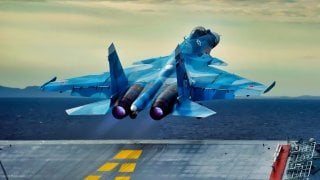China's J-15 Fighter Has Some Russia and Ukraine DNA
Given the rising tensions between the U.S. and China, it should come as no surprise that the J-15 is being measured first and foremost against its American counterpart.
Summary: The Shenyang J-15 "Flying Shark," known as Flanker-X2 by NATO, is a cornerstone of China's carrier-based air power, introduced in 2013 to operate from the People's Liberation Army Navy's aircraft carriers. Originating from failed negotiations to acquire the Russian Sukhoi Su-33, China initiated the J-15 program by reverse-engineering a Su-33 prototype obtained from Ukraine.

-The aircraft, which first flew in 2009, initially used a Russian Saturn AL-31 engine but has since transitioned to the Chinese-made WS-10B engine for enhanced performance and reliability.
-The J-15, structurally reinforced for carrier operations and boasting impressive aerodynamic capabilities, is designed to compete with advanced Western fighters like the U.S. F/A-18 Super Hornet, particularly in terms of aerodynamics, although it still seeks advancements in electronics and combat systems.
China's J-15 Flying Shark: A Closer Look at the Carrier-Based Fighter
The Shenyang J-15 “Flying Shark” is a Chinese fighter jet known to NATO as the Flanker-X2. Introduced in 2013, the J-15 is an all-weather, twinjet, carrier-based multirole aircraft.
To date, sixty J-15s have been built, all to operate from People’s Liberation Army Navy aircraft carriers and further complement China’s growing naval prowess.
Developing the J-15
China, seeking to improve its naval aviation capabilities, made multiple attempts to purchase the carrier-capable Sukhoi Su-33 from Russia. According to Moscow, the bid failed when Russia learned that China had developed its own modified version of the Sukhoi Su-27SK.
That aircraft was designated the J-11B and violated intellectual property agreements between the two nations. According to the Chinese, however, the Su-33 bid failed because Russia demanded a purchase of at least fifty Su-33s and a payment large enough to cover the costs of reopening Su-33 production lines.

Whatever the true reason for the failed Su-33 bid, the blundered negotiation opened the door for the production of the J-15. The program, which commenced in 2006, was an effort to reverse-engineer a Soviet Su-33 prototype that the Chinese had acquired from Ukraine.
The J-15 prototype made its maiden flight in 2009, reportedly using a Russian-supplied Saturn AL-31 turbofan engine. One year later, in 2010, the J-15 made its first takeoff from a ski-jump constructed on land to simulate a Chinese carrier. An actual carrier takeoff and landing wouldn’t occur until 2012 when a J-15 was deployed from Liaoning. The J-15 wasn’t limited to ski-jump takeoffs; a version was developed with CATOBAR launch capability.
In November 2022, a J-15 with a Chinese-made WS-10B engine appeared in the media. The Chinese had replaced the Russian engine with a domestically made engine, reportedly because the WS-10 offered superior safety, reliability, and service life over the Russian Saturn engine.

Structurally, the J-15 is reinforced to accommodate the stress of carrier operations. Much of the airframe was built from composite materials to save weight and improve aerodynamic performance. The J-15 has a slower, safer landing speed than the Su-33.
Chinese media complimented the J-15’s abilities, suggesting that the new jet “likely exceeds the aerodynamic capabilities of virtually any fighter aircraft currently operated by regional militaries, except for the U.S. F-22 Raptor” on account of the J-15 likely possessing a 10 percent greater thrust-to-weight ratio and 25 percent lower wing loading than the American F/A-18 Super Hornet.

The J-15’s chief designer, Sun Cong, argues that the J-15 could challenge the F/A-18 in bomb load, combat radius, and mobility but acknowledges that the J-15 needs improved electronics and combat systems. Rear Adm. Yin Zhuo asserts that the J-15 has superior air combat capabilities to the F/A-18 while acknowledging that the Super Hornet is superior with respect to attacking land and sea targets.
Given the rising tensions between the U.S. and China, it should come as no surprise that the J-15 is being measured first and foremost against its American counterpart.
About the Author: Harrison Kass
Harrison Kass is a defense and national security writer with over 1,000 total pieces on issues involving global affairs. An attorney, pilot, guitarist, and minor pro hockey player, Harrison joined the U.S. Air Force as a Pilot Trainee but was medically discharged. Harrison holds a BA from Lake Forest College, a JD from the University of Oregon, and an MA from New York University. Harrison listens to Dokken.


